How do bike gears work? They allow you to maintain a comfortable pedaling speed regardless of the terrain. Understanding gear systems and optimizing them for your motorcycle is very important. At usabikers.net, we want to equip you with the knowledge to select the right gear for the terrain, maintain an efficient cadence, and customize your bike to your riding style. Whether you’re a beginner or an experienced biker, understanding how gears work enhances your riding experience and performance. You’ll become a master of transmission, bicycle mechanics, and gear ratios.
1. Understanding Bike Gears: The Basics
1.1. What Determines the Number of Bike Gears You Have?
The number of gears on a bike is determined by multiplying the number of sprockets at the rear (cassette) by the number of chainrings at the front. For example, a bike with two chainrings and a 12-speed cassette has 24 gears. Each combination of chainring and sprocket provides a different gear ratio, affecting how easy or difficult it is to pedal. This is a simple calculation, with the total number of gears calculated based on the number of front chainrings multiplied by the number of rear sprockets.
To further clarify:
- A bike with two chainrings and an 11-speed cassette has 22 gears.
- A bike with a triple chainring and an 8-speed cassette has 24 gears.
Knowing this helps you quickly understand the range of options your bike offers and how to use them effectively.
1.2. Why Do You Need Gears on a Road Bike?
Gears on a road bike enable you to maintain a comfortable pedaling speed, or cycling cadence, regardless of the gradient or terrain. No single gear can accomplish this. Gears help you optimize your effort, whether climbing a steep hill or cruising on flat ground. Gears provide the flexibility to adjust to different conditions, making your ride more efficient and enjoyable.
Here’s how gears work in different scenarios:
- High Gear: Optimal for descending or riding at high speeds, achieved by combining the largest front chainring with the smallest rear sprocket (e.g., 50×11).
- Low Gear: Best for climbing steep inclines, achieved by combining the smallest front chainring with the largest rear sprocket.
Having a wide range of gears isn’t about making the bike faster, but about improving efficiency. More gears provide more options to find your preferred pedaling speed, similar to how a car benefits from different gears for acceleration and high-speed cruising.
 A male cyclist using the gears on his bike as he climbs a mountain
A male cyclist using the gears on his bike as he climbs a mountain
1.3. Why Do Some People Opt for a Single Speed Bike?
Some cyclists choose single-speed bikes for their simplicity and low maintenance, especially for commuting in flat areas. Single-speed bikes have one gear, determined by the size of the front chainring and rear cog. They eliminate the complexity of multiple gears and derailleurs. Single-speed bikes are reliable and require minimal upkeep, making them ideal for urban environments and riders who prefer a straightforward cycling experience.
Single-speed bikes are also used by racers (e.g., hill climbers) who want to reduce weight and eliminate shifting complications. In these cases, choosing the correct gear ratio is crucial. Track bikes also typically have only one gear.
However, the simplicity comes with trade-offs:
- Limited Versatility: Single-speed bikes are not suitable for varied terrains or steep hills.
- Higher Physical Demand: Requires more effort to maintain speed on different surfaces.
Despite these limitations, many riders appreciate the direct feel and simplicity of a single-speed bike.
1.4. Overlapping Gears and Chain Crossing
In multi-geared setups, especially those with 22 or more gears, overlapping gear ratios are unavoidable. Some gear combinations will result in the same ratio as others using different sprockets and chainrings. For example, 53×19 is the same gear as 39×14. Additionally, certain crossover gears at the extremes of the range may not be recommended due to the strain on the chain.
Old-fashioned advice, which remains relevant, is to avoid crossing the chain. This means avoiding combinations where the chain is at an extreme angle, such as the largest front chainring with the largest rear sprocket, or the smallest front chainring with the smallest rear sprocket. Crossing the chain can lead to:
- Increased Wear and Tear: Excessive strain on the chain and drivetrain components.
- Reduced Efficiency: Creates more friction and requires more effort to pedal.
- Poor Shifting Performance: Can cause the chain to skip or not shift smoothly.
The key benefit of having many gears is not the total number, but the ability to have a continual progression of closely spaced gears, which enhances pedaling efficiency. Modern bikes offer an extensive range of gearing options, allowing cyclists of all abilities to maximize their pedaling efforts.
 Three chainsets shown in relation to each other so you can see how different gears on a bike work
Three chainsets shown in relation to each other so you can see how different gears on a bike work
2. Types of Bike Gears and How They Work
2.1. Standard Double
A standard double setup includes two chainrings at the front paired with up to 12 sprockets at the rear. Traditionally, a 53-39t combination is known as a standard chainset, though it’s now less common among recreational cyclists and rarely specified on bikes by manufacturers. This setup is often preferred for racing, offering the largest chainring sizes for high-speed pedaling.
Key features of a standard double:
- High Gear Ratios: Ideal for maintaining speed in flat and downhill conditions.
- Limited Low Gearing: Inner chainring typically only goes down to 38t, not ideal for steep climbs.
2.2. Compact
A compact setup is a smaller version of the double, with reduced chainring sizes, typically a 34t or 36t inner ring paired with a 48t or 50t outer ring. This setup reduces the gear ratio across the range, making it a popular choice for riders who want a balance of climbing ability and speed. Compact setups provide sufficient low-end gearing to tackle steep climbs, while still allowing for fast descending and speed on the flats.
Advantages of a compact setup:
- Improved Climbing Ability: Smaller inner chainring makes it easier to pedal uphill.
- Versatile Performance: Suitable for various terrains, from steep climbs to flat roads.
2.3. Semi-Compact
Semi-compact chainsets have become increasingly popular, offering a balance between standard and compact setups. They typically feature a 52t outer chainring paired with a 36t inner ring. This combination provides the best of both worlds, offering enough low gears for climbing while still providing a bigger gear for fast group riding and descending. Semi-compact setups are a go-to choice for race-oriented bikes sold with a Shimano or Campagnolo double-ring setup.
Benefits of a semi-compact setup:
- Balanced Gearing: Suitable for both climbing and high-speed riding.
- Wide Compatibility: Works well with various cassette sizes, such as 11-28, 11-30, or 11-32.
2.4. Triple
Triple cranksets are less common these days and are typically found on hybrid or touring bikes. The benefit of a triple crankset is that it provides a wide gearing range without needing as many sprockets on the cassette. The tiny inner rings allow for a smaller bottom gear than a double crankset. If you plan on doing loaded touring, this is a great option.
Advantages of a triple crankset:
- Extensive Gear Range: Provides a wide range of gear options for varied terrains.
- Cost-Effective: Often cheaper than other gearing options due to fewer cassette sprockets.
2.5. SRAM AXS
SRAM AXS groupsets feature smaller chainrings and a 12-speed cassette that starts with a 10-tooth sprocket. Available options include 50/37T, 48/35T, 46/33T, and even a 43/30T in Force and Rival builds. This design prioritizes small jumps between the smaller sprockets while balancing that with larger jumps between the bigger sprockets, providing a wide overall range.
The benefits of SRAM AXS are:
- Optimized Cadence: Small changes in cadence when riding hard and fast on the flat.
- Enhanced Climbing: Plenty of lower gears when the road points up, with larger jumps allowing you to shift into easier gears as gradients increase.
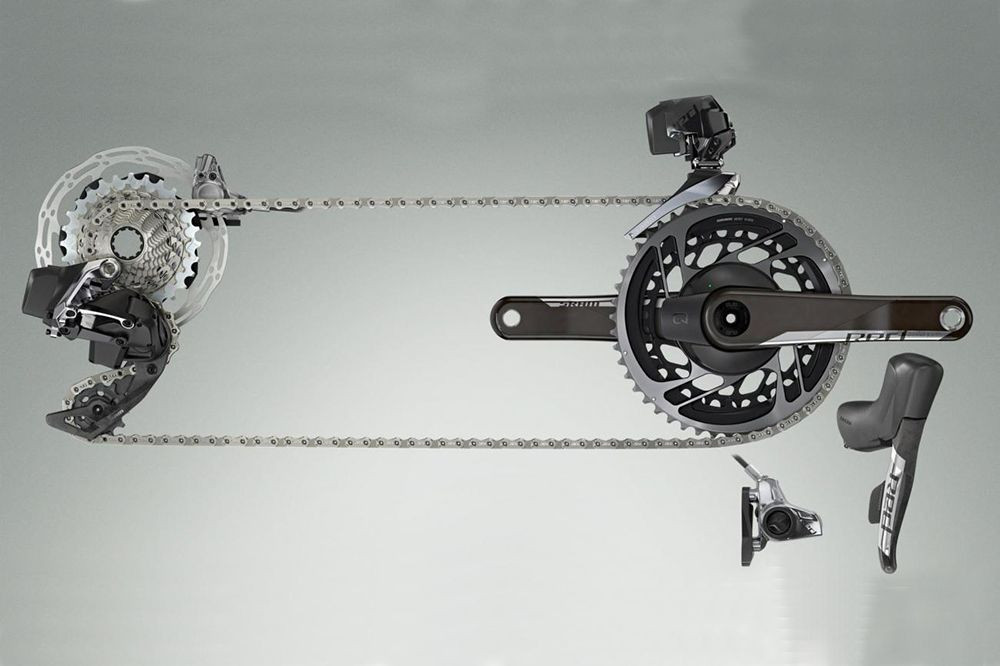 SRAM Red eTap AXS
SRAM Red eTap AXS
2.6. 1x or Single Chainring
Single chainring setups, popularized by SRAM and also offered by Shimano and Campagnolo, pair one chainring with a multi-speed cassette, typically 11, 12, or 13-speed. Favored for their simplicity, they eliminate the need for a front derailleur, making shifting straightforward. Special chainrings and rear derailleurs with a clutch mechanism ensure the chain remains in place.
1x setups are popular among gravel riders, where chain retention is vital and bigger gear jumps are less problematic. Shimano’s GRX and Campagnolo’s Ekar groupsets are gravel-specific 1x offerings. Even SRAM has updated its Red AXS 1x groupset to 13 gears.
Benefits of 1x setups:
- Simplicity: Easier shifting with no front derailleur.
- Improved Chain Retention: Special chainrings and clutch mechanisms keep the chain secure.
- Aerodynamic Advantages: One less derailleur
However, 1x groupsets aren’t just for gravel. They can be a great option for crit racers or riders who predominantly ride on flat terrain. Some SRAM-sponsored WorldTour teams have experimented with single chainring setups to maintain an optimal chainline. The simplicity also makes them ideally suited for cycling newbies.
2.7. Hub Gears
Hub gears are robust, low-maintenance planetary gear systems housed in a rear hub. The popular Rohloff hub has 14 gears, while options with four, seven, eight, nine, and 12-speeds are available from SRAM, Shimano, and Sturmey-Archer. While the choice of individual gears may be less than with a derailleur system, it’s still possible to personalize ratios by playing with chainring and rear sprocket sizes.
Hub gears are tough and require very little maintenance, making them great for everyday commuter bikes. Most allow you to change gear without pedaling, which is handy at traffic lights. However, their weight can be a disadvantage in hillier terrain and on endurance rides.
In 2019, Classified, a Belgian tech company, released its Powershift system, a wireless electronic hub system that now boasts 24 gears and instant shifting, even under load. While the hub requires a compatible wheelset, a growing number of wheel brands now offer a Classified option. It has even been used in WorldTour races.
Advantages of hub gears:
- Low Maintenance: Sealed system protects gears from the elements.
- Durable: Robust construction for long-lasting performance.
- Convenient Shifting: Ability to shift gears without pedaling.
 Hub-gears
Hub-gears
3. Road Bike Gear Shifters: How They Work
3.1. Mechanical Gear Shifters
With modern designs, it’s not always immediately obvious where the shift levers are. Regardless of brand, right-hand levers control the rear derailleur, and left-hand levers control the front. If you’re in doubt, a local bike shop can run through this with you.
 Diagram showing how Campagnolo road bike gear shifters work
Diagram showing how Campagnolo road bike gear shifters work
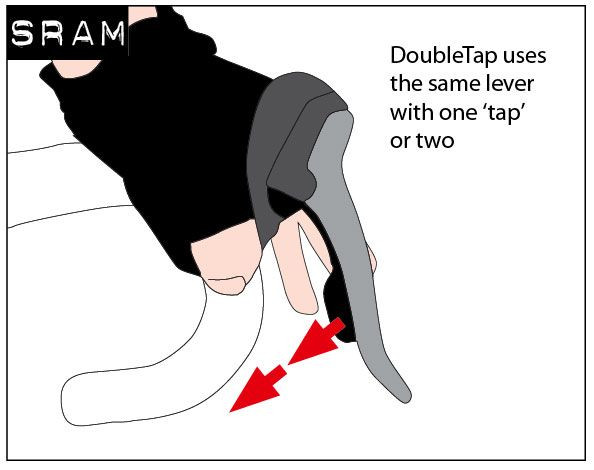 Diagram showing how SRAM road bike gear shifters work
Diagram showing how SRAM road bike gear shifters work
 Diagram showing how Shimano road bike gear shifters work
Diagram showing how Shimano road bike gear shifters work
3.2. Electronic Gear Shifters
Electronic gears often work differently, and some, like SRAM AXS and the latest iteration of Shimano Di2, can even be customized to the rider’s preference.
4. How Does Electric Road Bike Gear Shifting Work?
4.1. Shimano Di2
Shimano’s electronic Di2 groupsets (Dura-Ace, Ultegra, 105) work with a button system, but with the same principle as the mechanical shifters. The left shifter operates the front derailleur, and the right operates the rear.
There are two buttons behind the brake lever on each shifter. On the left, the slimmer dimpled inside button shifts the chain up from the small ring to the big ring. The smooth paddle-shaped outer button below moves the chain down from the big ring to the small outer ring.
On the right shifter, the inner dimpled button moves the chain up the cassette to easier gears, while the smooth outer button moves the chain towards the harder gears if you’re riding faster.
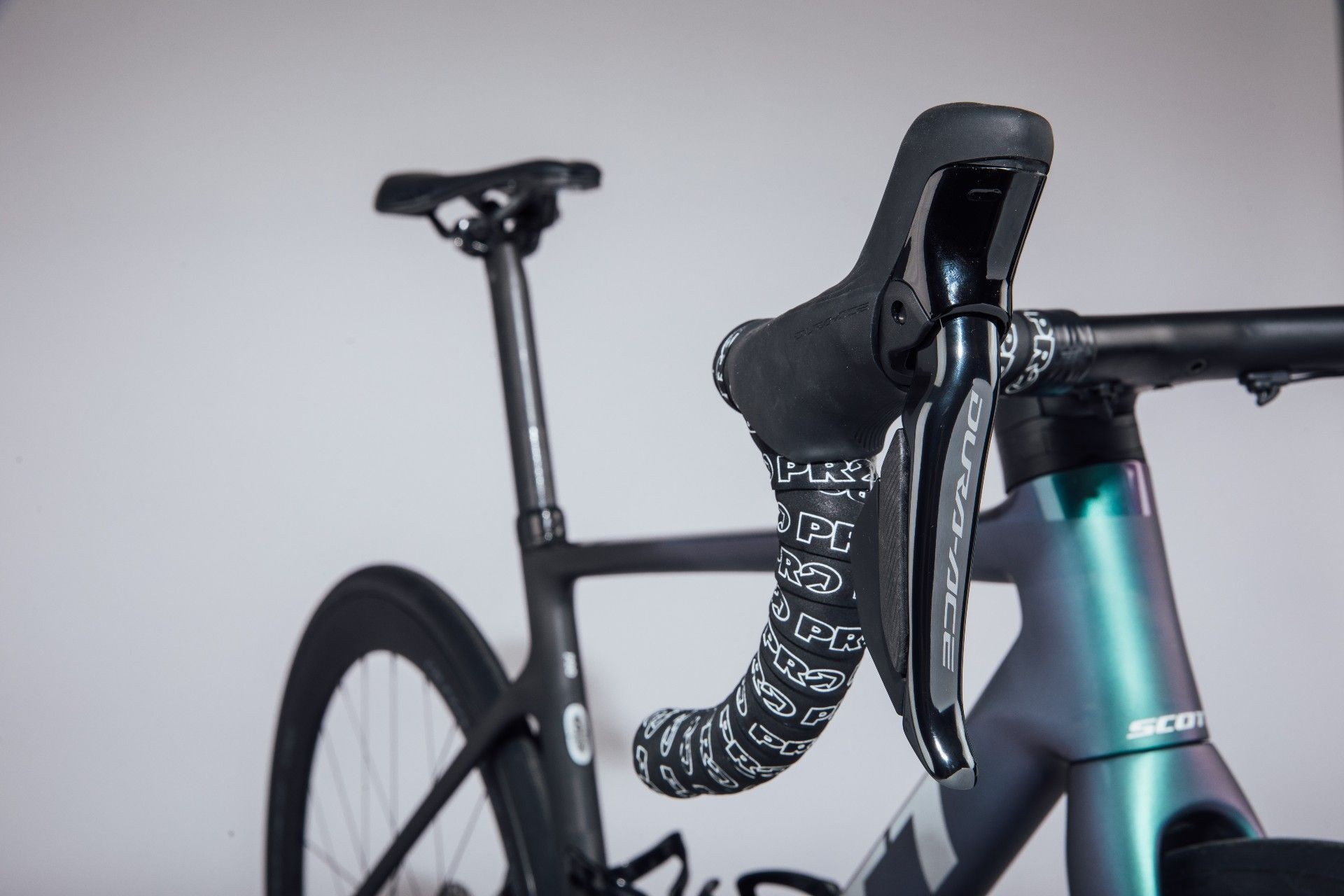 Shimano Dura Ace shifter for changing gears on a bike
Shimano Dura Ace shifter for changing gears on a bike
4.2. Campagnolo Super Record EPS
Campagnolo Super Record EPS shifters feature a button behind the brake lever and a thumb button inside the shifter hood, similar to its mechanical cousin.
On the right-hand shifter, the button behind the brake lever moves the chain up the cassette into an easier gear. The thumb button does the opposite and moves the chain into a harder gear at the rear. EPS also offers multi-shift, so if you hold the button down, the chain will shift multiple gears until you release the button.
On the left-hand shifter, the paddle button behind the lever moves the chain from the inner small ring to the larger outer ring. The left-hand thumb button does vice versa.
Campag has also introduced Super Record WRL, a wireless groupset that drops the thumb buttons for those more in line with Shimano and SRAM’s shifter buttons.
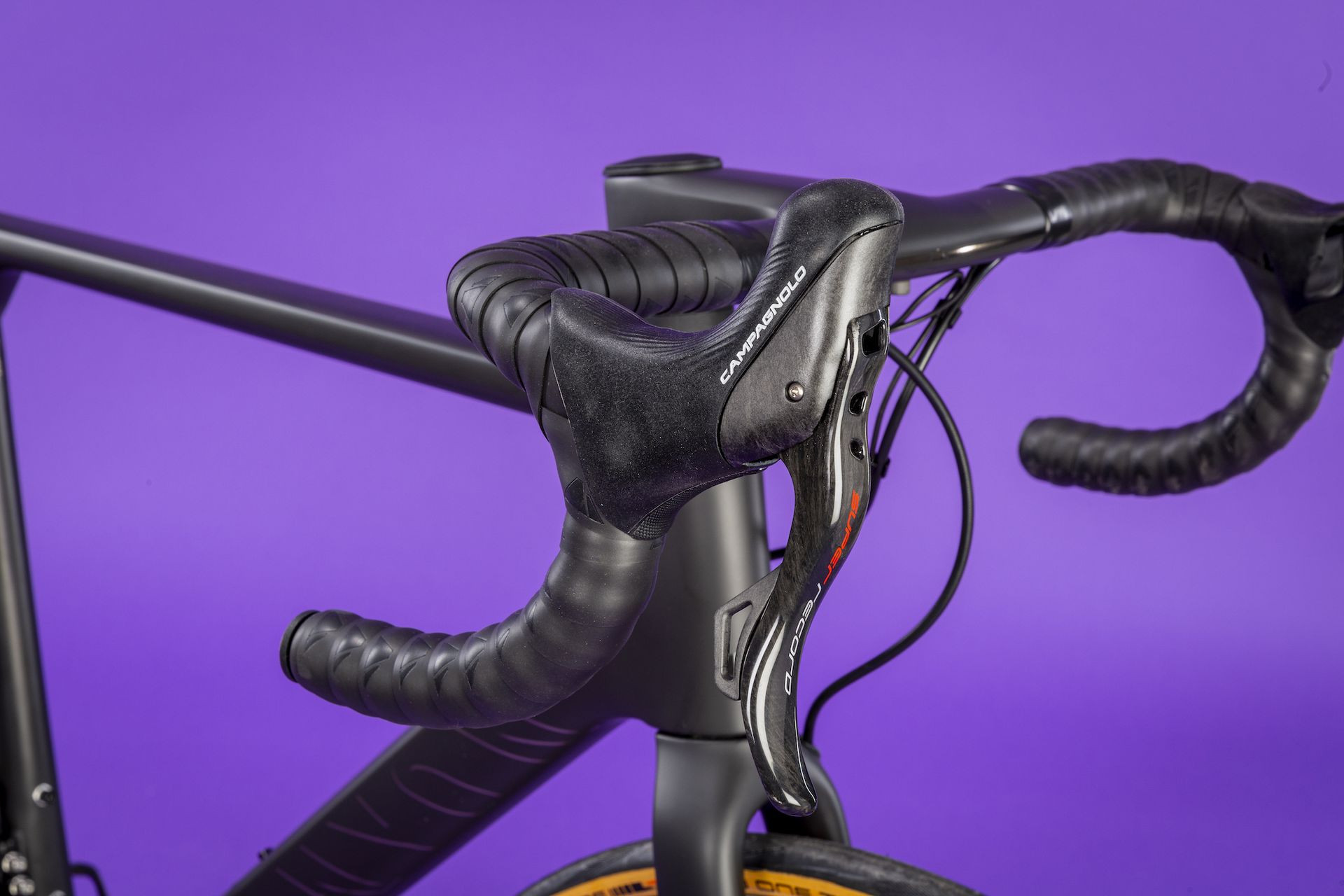 Campagnolo Super Record EPS shifter
Campagnolo Super Record EPS shifter
4.3. SRAM AXS
SRAM eTap AXS (Red, Force, Rival, and Apex groupsets) works differently from mechanical SRAM groupsets and competing electronic groupsets.
SRAM AXS shifting setup is customizable, but the default setting uses just two buttons. The right-hand paddle button, behind the brake lever, moves the chain into a harder gear on the cassette. The left-hand paddle button moves the chain up the cassette into an easier gear.
To move the chain between the two front chainrings, the rider simply needs to push both the left-hand button and right-hand button simultaneously, and the chain will move up or down depending on its starting position.
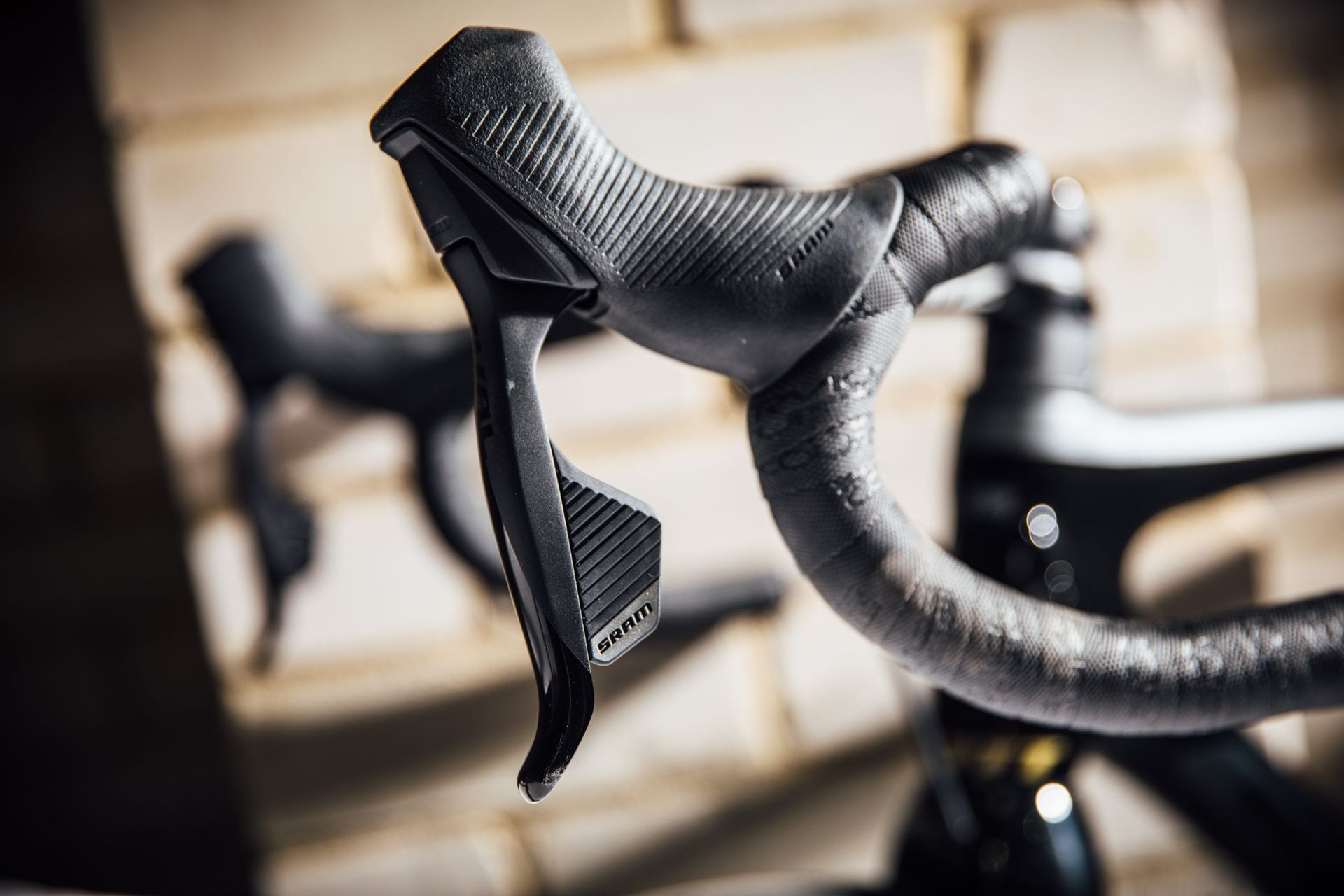 SRAM Rival eTap AXS shifter for changing gears on a bike
SRAM Rival eTap AXS shifter for changing gears on a bike
5. Key Factors When Choosing Your Bike Gear System
5.1. Terrain
Where you typically ride significantly impacts the gearing you need. Hilly areas demand a wider range of gears with lower ratios to ease climbs. Flat terrains, on the other hand, might only require a few gears optimized for speed and efficiency.
5.2. Fitness Level
Your fitness level should also influence your gear selection. Beginners or those with lower fitness levels benefit from gears that allow for easier pedaling, while more experienced riders might prefer higher gears for speed and power.
5.3. Riding Style
Consider how you typically ride. Are you a casual rider, a commuter, a racer, or an off-road adventurer? Each style benefits from different gear ratios and systems designed to optimize performance for those specific conditions.
5.4. Maintenance
Think about how much maintenance you’re willing to perform. Simpler systems like single-speed bikes require less upkeep than more complex multi-gear systems, which may need regular adjustments and cleaning.
6. Glossary: Understanding Bike Gear Terminology
- Chainring: Toothed ring at the front end of the drivetrain, attached to the crank.
- Cassette: Cluster of sprockets at the rear of the drivetrain, containing up to 12 gears of various sizes.
- Block: Another term for the group of rear sprockets, but really refers to the older, screw-on freewheel.
- Derailleurs: Front and rear derailleurs move the chain from one sprocket (or chainring) to the next.
- Sprocket: Refers to an individual gear within the cassette/block.
- Ratio: Describes the relationship between sprockets and chainrings, for example, ‘53×12’ or the sprockets on a cassette (11-28).
- t: Short for teeth—to describe how many a given sprocket has—for example, ‘23t’.
- Drivetrain: The term groups together all the moving parts that connect the crank to the rear wheel and hence drive a bicycle along—namely the chain, the cassette, and the chainrings.
- Cadence: Pedaling speed, measured from how many revolutions the crank makes per minute—expressed in RPM.
- STI lever: Abbreviation of ‘Shimano Total Integration’—a term for Shimano’s design combining brake and shift levers for road bikes, but often (mis)used generically to refer to the shift/brake levers regardless of brand.
- Ergo lever: Campagnolo’s name for its version of integrated gear shift and brake levers (ie Campagnolo’s STI).
- DoubleTap lever: SRAM’s version of shifter technology—uses the same lever for upshifts and downshifts.
7. Common Questions About Bike Gears (FAQ)
7.1. How Do I Know What Gear to Use on a Bike?
Select a gear that allows you to pedal comfortably at a consistent cadence. Use higher gears for flat or downhill sections and lower gears for uphill sections.
7.2. What Is the Easiest Gear on a Bike?
The easiest gear is the combination of the smallest front chainring and the largest rear sprocket.
7.3. How Often Should I Replace My Bike Chain?
Replace your bike chain every 2,000 to 3,000 miles, or more frequently if you ride in harsh conditions.
7.4. Can I Change Gears While Stationary?
While possible with some hub gear systems, it’s generally best to change gears while pedaling to ensure smooth transitions.
7.5. What Is the Difference Between a Cassette and a Freewheel?
A cassette slides onto a freehub body and is secured with a lockring, while a freewheel screws onto the hub and includes the ratcheting mechanism.
7.6. How Do I Maintain My Bike Gears?
Keep your chain clean and lubricated, and regularly inspect your derailleurs and cables for wear and proper adjustment.
7.7. Is It Better to Have More Gears on a Bike?
More gears provide a wider range of options and finer adjustments, but the optimal number depends on your riding style and terrain.
7.8. What Are the Benefits of Electronic Shifting?
Electronic shifting offers precise and consistent gear changes, easy operation, and customization options.
7.9. How Do I Adjust My Bike Derailleurs?
Adjust your derailleurs using the barrel adjusters to fine-tune the cable tension and ensure smooth shifting.
7.10. What Is Gear Ratio and Why Does It Matter?
Gear ratio is the relationship between the number of teeth on the front chainring and the rear sprocket, affecting how easy or difficult it is to pedal. A lower gear ratio makes pedaling easier, while a higher gear ratio allows for greater speed.
8. How Gears Affect Your Motorcycle Riding Experience
8.1. Improving Climbing
Lower gears make climbing easier by reducing the force required to turn the pedals. This allows you to maintain a steady cadence and conserve energy on steep inclines.
8.2. Enhancing Speed
Higher gears allow you to cover more distance with each pedal stroke, increasing your speed on flat roads and descents.
8.3. Optimizing Cadence
Choosing the right gear helps you maintain an efficient pedaling cadence, which minimizes strain on your muscles and improves overall performance.
8.4. Reducing Fatigue
Using appropriate gears for different terrains reduces fatigue by allowing you to maintain a consistent effort level, rather than straining in too high or spinning out in too low of a gear.
9. Modern Trends in Bike Gear Technology
9.1. Wireless Electronic Shifting
Wireless electronic shifting systems like SRAM AXS offer clean aesthetics, precise shifting, and easy customization. These systems eliminate cables, reducing maintenance and improving reliability.
9.2. 1x Drivetrains
1x drivetrains are gaining popularity for their simplicity, reduced weight, and improved chain retention. They are particularly well-suited for gravel riding and mountain biking.
9.3. Wide-Range Cassettes
Wide-range cassettes provide a broad spectrum of gear options, allowing riders to tackle a variety of terrains without sacrificing efficiency or comfort.
9.4. Integrated Hub Gears
Integrated hub gears offer low maintenance and reliable performance, making them a popular choice for commuter bikes and touring bikes.
10. Optimizing Bike Gears for Different Riding Styles
10.1. Road Biking
For road biking, consider a semi-compact or compact crankset with a wide-range cassette to handle both climbs and fast descents. Electronic shifting can provide precise and consistent gear changes.
10.2. Mountain Biking
Mountain bikers often prefer 1x drivetrains with wide-range cassettes for their simplicity and reliability on rough terrain. Clutch derailleurs improve chain retention and reduce noise.
10.3. Gravel Riding
Gravel riders benefit from 1x or 2x drivetrains with wide-range cassettes to handle varied terrain and steep climbs. Durable components and reliable shifting are essential.
10.4. Touring
Touring bikes often use triple cranksets or hub gears to provide a wide range of gear options for carrying heavy loads and tackling diverse terrain. Reliability and low maintenance are key considerations.
10.5. Commuting
Commuter bikes often feature hub gears or single-speed drivetrains for their simplicity and low maintenance. Fenders and racks add practicality for daily use.
Understanding how bike gears work is essential for every motorcycle enthusiast. By selecting the right gear system for your needs, you can optimize your riding experience and enhance your enjoyment on the road.
Visit usabikers.net for more information, detailed guides, and to connect with a community of passionate riders. Discover new articles, engage in discussions, and find the resources you need to make the most of your motorcycle journey.
Address: 801 Sturgis Main St, Sturgis, SD 57785, United States.
Phone: +1 (605) 347-2000.
Website: usabikers.net.
